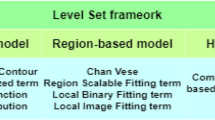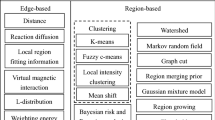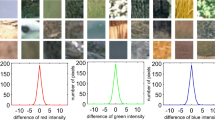Abstract
Image segmentation is a fundamental task in computer vision and image processing. Due to the presence of high noise, low resolution and intensity inhomogeneity, it is still a difficult problem in the practical applications. Level set methods have been widely used in image processing and computer vision. During the past decades, many models based on level set methods have been proposed to solve image segmentation with intensity inhomogeneity. It is necessary to conduct a comprehensive review and comparison of these models. Specifically, level set methods can be categorized into two groups, including edge-based level set methods (EBLSMs) and region-based level set methods (RBLSMs). This paper reviews some of the recent advances in EBLSMs and RBLSMs for segmenting image with intensity inhomogeneity. Their advantages and disadvantages are discussed in an objective point of view, and their performance is compared on image segmentation with intensity inhomogeneity. Finally, this paper further explores and discusses some open questions in segmenting images with intensity inhomogeneity.








Similar content being viewed by others
References
Abdel Maksoud E, Elmogy M, Al-Awadi R (2015) Brain tumor segmentation based on a hybrid clustering technique. Egypt Inform J 16(1):71–81
Allaire G, Jouve F, Toader A M (2004) Structural optimization using sensitivity analysis and a level-set method. J Comput Phys 194(1):363–393
Arteaga-Salas J M, Zuzan H, Langdon W B, et al. (2007) An overview of image-processing methods for Affymetrix GeneChips. Brief Bioinform 9 (1):25–33
Barles G, Soner H M, Souganidis P E (1993) Front propagation and phase field theory. SIAM J Control Optim 31(2):439–469
Bengio Y, Simard P, Frasconi P (1994) Learning long-term dependencies with gradient descent is difficult. IEEE Trans Neural Netw 5(2):157–166
Brox T (2005) From pixels to regions: partial differential equations in image analysis. Verlag Nicht Ermittelbar
Brox T, Weickert J (2004) Level set based image segmentation with multiple regions. In: Joint pattern recognition symposium. Springer, Berlin, pp 415–423
Cardinal M H R, Meunier J, Soulez G, et al. (2006) Intravascular ultrasound image segmentation: a three-dimensional fast-marching method based on gray level distributions. IEEE Trans Med Imaging 25(5):590–601
Caselles V, Catte F, Catté T, et al. (1993) A geometric model for active contours in image processing. Numer Math 66(1):1–31
Caselles V, Kimmel R, Sapiro G (1997) Geodesic active contours. Int J Comput Vis 22(1):61–79
Chan T F, Vese L A (2001) Active contours without edges. IEEE Trans Image Process 10(2):266–277
Chan T, Zhu W (2005) Level set based shape prior segmentation. In: 2005 IEEE computer society conference on computer vision and pattern recognition (CVPR’05), vol 2. IEEE, pp 1164–1170
Chan T F, Sandberg B Y, Vese L A (2000) Active contours without edges for vector-valued images. J Vis Commun Image Represent 11(2):130–141
Chan T F, Esedoglu S, Nikolova M (2006) Algorithms for finding global minimizers of image segmentation and denoising models. SIAM J Appl Math 66(5):1632–1648
Chen Y, Zhang J, Macione J (2009) An improved level set method for brain MR images segmentation and bias correction. Comput Med Imaging Graph 33(7):510–519
Choy S K, Lam S Y, Yu K W, et al. (2017) Fuzzy model-based clustering and its application in image segmentation. Pattern Recognit 68:141–157
Cremers D, Rousson M, Deriche R (2007) A review of statistical approaches to level set segmentation: integrating color, texture, motion and shape. Int J Comput Vis 72(2):195–215
Dong Y, Du B, Zhang L, et al. (2016) Exploring locally adaptive dimensionality reduction for hyperspectral image classification: a maximum margin metric learning aspect. IEEE J Sel Top Appl Earth Obs Remote Sens 10(3):1136–1150
Enright D, Fedkiw R, Ferziger J, et al. (2002) A hybrid particle level set method for improved interface capturing. J Comput Phys 183(1):83–116
Flaxman A D, Kalai A T, Kalai A T, et al. (2005) Online convex optimization in the bandit setting: gradient descent without a gradient. In: Proceedings of the sixteenth annual ACM-SIAM symposium on discrete algorithms. Society for Industrial and Applied Mathematics, pp 385–394
Fu G, Huang M, Bo W, et al. (2017) Mapping morphological shape as a high-dimensional functional curve. Brief Bioinform 19(3):461–471
Girshick R, Donahue J, Darrell T, et al. (2015) Region-based convolutional networks for accurate object detection and segmentation. IEEE Trans Pattern Anal Mach Intell 38(1):142–158
Gomes J, Faugeras O (2000) Reconciling distance functions and level sets. J Vis Commun Image Represent 11(2):209–223
He L, Peng Z, Everding B, et al. (2008) A comparative study of deformable contour methods on medical image segmentation. Image Vis Comput 26 (2):141–163
Ji Z, Xia Y, Sun Q, et al. (2015) Active contours driven by local likelihood image fitting energy for image segmentation. Inf Sci 301:285–304
Jiang X L, Wang Q, He B, et al. (2016) Robust level set image segmentation algorithm using local correntropy-based fuzzy c-means clustering with spatial constraints. Neurocomputing 207:22–35
Kass M, Witkin A, Terzopoulos D (1988) Snakes: active contour models. Int J Comput Vis 1(4):321–331
Kim B C, Mun D (2014) Feature-based simplification of boundary representation models using sequential iterative volume decomposition. Comput Graph 38:97–107
Kim B C, Mun D (2015) Enhanced volume decomposition minimizing overlapping volumes for the recognition of design features. J Mech Sci Technol 29 (12):5289–5298
Kimmel R, Amir A, Bruckstein A M (1995) Finding shortest paths on surfaces using level sets propagation. IEEE Trans Pattern Anal Mach Intell 17 (6):635–640
Kivinen J, Warmuth M K (1997) Exponentiated gradient versus gradient descent for linear predictors. Inf Comput 132(1):1–63
Lankton S, Tannenbaum A (2008) Localizing region-based active contours. IEEE Trans Image Process 17(11):2029–2039
Lee S H, Seo J K (2006) Level set-based bimodal segmentation with stationary global minimum. IEEE Trans Image Process 15(9):2843–2852
Li C, Kao C Y, Gore J C, et al. (2007) Implicit active contours driven by local binary fitting energy. In: IEEE conference on computer vision and pattern recognition. IEEE, pp 1–7
Li C, Kao C Y, Gore J C, et al. (2008) Minimization of region-scalable fitting energy for image segmentation. IEEE Trans Image Process 17 (10):1940–1949
Li C, Xu C, Gui C, et al. (2010) Distance regularized level set evolution and its application to image segmentation. IEEE Trans Image Process 19 (12):3243–3254
Li C, Huang R, Ding Z, et al. (2011) A level set method for image segmentation in the presence of intensity inhomogeneities with application to MRI. IEEE Trans Image Process 20(7):2007–2016
Li C, Gore J C, Davatzikos C (2014) Multiplicative intrinsic component optimization (MICO) for MRI bias field estimation and tissue segmentation. Magn Reson Imaging 32(7):913–923
Liu L K, Feig E (1996) A block-based gradient descent search algorithm for block motion estimation in video coding. IEEE Trans Circ Syst Video Technol 6(4):419–422
Liu H, Chen Y, Chen W (2006) Neighborhood aided implicit active contours. In: 2006 IEEE Computer Society conference on computer vision and pattern recognition (CVPR’06), vol 1. IEEE, pp 841–848
Liu C, Liu W, Xing W (2017) An improved edge-based level set method combining local regional fitting information for noisy image segmentation. Signal Process 130:12–21
Liu C, Liu W, Xing W (2019) A weighted edge-based level set method based on multi-local statistical information for noisy image segmentation. J Vis Commun Image Represent 59:89–107
Luo Z, Tong L, Wang M Y, et al. (2007) Shape and topology optimization of compliant mechanisms using a parameterization level set method. J Comput Phys 227(1):680–705
Ma S, Huang J (2008) Penalized feature selection and classification in bioinformatics. Brief Bioinform 9(5):392–403
Maitre E, Milcent T, Cottet G H, et al. (2009) Applications of level set methods in computational biophysics. Math Comput Model 49(11–12):2161–2169
Malik J, Belongie S, Leung T, et al. (2001) Contour and texture analysis for image segmentation. Int J Comput Vis 43(1):7–27
Malladi R, Sethian J A (1996) Level set and fast marching methods in image processing and computer vision. In: Proceedings of 3rd IEEE international conference on image processing, vol 1. IEEE, pp 489–492
Min H, Jia W, Wang X F, et al. (2015) An intensity-texture model based level set method for image segmentation. Pattern Recognit 48(4):1547–1562
Min H, Wang X F, Huang D S, et al. (2016) A novel dual minimization based level set method for image segmentation. Neurocomputing 214:910–926
Min S, Lee B, Yoon S (2017) Deep learning in bioinformatics. Brief Bioinform 18(5):851–869
Mumford D, Shah J (1989) Optimal approximations by piecewise smooth functions and associated variational problems. Commun Pure Appl Math 42(5):577–685
Niu S, Chen Q, De Sisternes L, et al. (2017) Robust noise region-based active contour model via local similarity factor for image segmentation. Pattern Recognit 61:104–119
Osher S, Fedkiw R P (2001) Level set methods: an overview and some recent results. J Comput Phys 169(2):463–502
Osher S, Sethian J A (1988) Fronts propagating with curvature-dependent speed: algorithms based on Hamilton-Jacobi formulations. J Comput Phys 79 (1):12–49
Padfield D, Rittscher J, Thomas N, et al. (2009) Spatio-temporal cell cycle phase analysis using level sets and fast marching methods. Med Image Anal 13(1):143–155
Pal N R, Pal S K (1993) A review on image segmentation techniques. Pattern Recognit 26(9):1277–1294
Paragios N, Deriche R (2000) Geodesic active contours and level sets for the detection and tracking of moving objects. IEEE Trans Pattern Anal Mach Intell 22(3):266–280
Peng D, Merriman B, Osher S, et al. (1999) A PDE-based fast local level set method. J Comput Phys 155(2):410–438
Ronfard R (1994) Region-based strategies for active contour models. Int J Comput Vis 13(2):229–251
Sethian J A (1996) A fast marching level set method for monotonically advancing fronts. Proc Natl Acad Sci 93(4):1591–1595
Sethian J A (2003) Level set methods and fast marching methods. J Comput Inf Technol 11(1):1–2
Srinivasan K S, Ebenezer D (2007) A new fast and efficient decision-based algorithm for removal of high-density impulse noises. IEEE Signal Process Lett 14(3):189–192
Sussman M, Fatemi E (1999) An efficient, interface-preserving level set redistancing algorithm and its application to interfacial incompressible fluid flow. SIAM J Sci Comput 20(4):1165–1191
Sussman M, Smereka P, Osher S (1994) A level set approach for computing solutions to incompressible two-phase flow. J Comput Phys 114(1):146–159
Tsai A, Yezzi A, Willsky A S (2001) Curve evolution implementation of the Mumford-Shah functional for image segmentation, denoising, interpolation, and magnification. Georgia Institute of Technology
Tseng P, Yun S (2009) A coordinate gradient descent method for nonsmooth separable minimization. Math Program 117(1–2):387–423
Vese L A, Chan T F (2002) A multiphase level set framework for image segmentation using the Mumford and Shah model. Int J Comput Vis 50 (3):271–293
Wang M Y, Wang X, Guo D (2003) A level set method for structural topology optimization. Comput Methods Appl Mech Eng 192(1–2):227–246
Wang L, He L, Mishra A, et al. (2009) Active contours driven by local Gaussian distribution fitting energy. Signal Process 89(12):2435–2447
Wang L, Li C, Sun Q, et al. (2009) Active contours driven by local and global intensity fitting energy with application to brain MR image segmentation. Comput Med Imaging Graph 33(7):520–531
Wang X F, Huang D S, Xu H (2010) An efficient local Chan–Vese model for image segmentation. Pattern Recognit 43(3):603–618
Wang L, Gao Y, Shi F, et al. (2015) LINKS: Learning-based multi-source IntegratioN frameworK for Segmentation of infant brain images. NeuroImage 108:160–172
Wang X F, Min H, Zhang Y G (2015) Multi-scale local region based level set method for image segmentation in the presence of intensity inhomogeneity. Neurocomputing 151:1086–1098
Weber M, Blake A, Cipolla R (2004) Sparse finite elements for geodesic contours with level-sets. In: European conference on computer vision. Springer, Berlin, pp 391–404
Wilkinson D J (2007) Bayesian methods in bioinformatics and computational systems biology. Brief Bioinform 8(2):109–116
Wu Q, Gan Y, Lin B, et al. (2015) An active contour model based on fused texture features for image segmentation. Neurocomputing 151:1133–1141
Xing F, Xie Y, Yang L (2015) An automatic learning-based framework for robust nucleus segmentation. IEEE Trans Med Imaging 35(2):550–566
Xu C, Prince J L (1998) Generalized gradient vector flow external forces for active contours. Signal Process 71(2):131–139
Xu C, Prince J L (1998) Snakes, shapes, and gradient vector flow. IEEE Trans Image Process 7(3):359–369
Yan Q, Yang L, Liang C, et al. (2016) Geometrically based linear iterative clustering for quantitative feature correspondence. Comput Graph Forum 35(7):1–10
Yang L, Yan Q, Fu Y, et al. (2017) Surface reconstruction via fusing sparse-sequence of depth images. IEEE Trans Vis Comput Graph 24 (2):1190–1203
Yu H, He F, Pan Y (2018) A novel region-based active contour model via local patch similarity measure for image segmentation. Multimed Tools Appl 77(18):24097–24119
Yu H, He F, Pan Y (2019) A novel segmentation model for medical images with intensity inhomogeneity based on adaptive perturbation. Multimed Tools Appl 78(9):11779–11798
Yu H, He F, Pan Y (2020) A scalable region-based level set method using adaptive bilateral filter for noisy image segmentation. Multimed Tools Appl 79:5743–5765
Zhang Y, Matuszewski B J, Shark L K, et al. (2008) Medical image segmentation using new hybrid level-set method. In: 2008 fifth international conference biomedical visualization: information visualization in medical and biomedical informatics. IEEE, pp 71–76
Zhang K, Song H, Zhang L (2010) Active contours driven by local image fitting energy. Pattern Recognit 43(4):1199–1206
Zhang K, Zhang L, Song H, et al. (2010) Active contours with selective local or global segmentation: a new formulation and level set method. Image Vis Comput 28(4):668–676
Zhang K, Zhang L, Song H, et al. (2012) Reinitialization-free level set evolution via reaction diffusion. IEEE Trans Image Process 22(1):258–271
Zhang K, Zhang L, Lam K M, et al. (2015) A level set approach to image segmentation with intensity inhomogeneity. IEEE Trans Cybern 46 (2):546–557
Zhao Y Q, Wang X H, Wang X F, et al. (2014) Retinal vessels segmentation based on level set and region growing. Pattern Recognit 47(7):2437–2446
Zhu S C, Yuille A (1996) Region competition: unifying snakes, region growing, and Bayes/MDL for multiband image segmentation. IEEE Trans Pattern Anal Mach Intell 9:884–900
Zhu G, Zhang S, Zeng Q, et al. (2007) Boundary-based image segmentation using binary level set method. Opt Eng 46(5):050501
Zhu Z, Lu J, Wang M, et al. (2018) A comparative study of algorithms for realtime panoramic video blending. IEEE Trans Image Process 27 (6):2952–2965
Zhu Z, Harowicz M, Zhang J, et al. (2018) Deep learning-based features of breast MRI for prediction of occult invasive disease following a diagnosis of ductal carcinoma in situ: preliminary data. In: Medical imaging 2018: computer-aided diagnosis, vol 10575. International Society for Optics and Photonics, p 105752W
Zhu Z, Albadawy E, Saha A, et al. (2019) Deep Learning for identifying radiogenomic associations in breast cancer. Comput Biol Med 109:85–90
Zinkevich M, Weimer M, Li L, et al. (2010) Parallelized stochastic gradient descent. Adv Neural Inf Process Syst 2595–2603
Acknowledgements
We would like to thank all the anonymous reviewers for their valuable comments. This work is supported by National Key R&D Program of China (GrantNo. 2017YFB0503004) and Hubei Provincial Natural Science Foundation of China(Grant No. 2019CFB797).
Author information
Authors and Affiliations
Corresponding author
Additional information
Publisher’s note
Springer Nature remains neutral with regard to jurisdictional claims in published maps and institutional affiliations.
Rights and permissions
About this article
Cite this article
Yu, H., He, F. & Pan, Y. A survey of level set method for image segmentation with intensity inhomogeneity. Multimed Tools Appl 79, 28525–28549 (2020). https://doi.org/10.1007/s11042-020-09311-9
Received:
Revised:
Accepted:
Published:
Issue Date:
DOI: https://doi.org/10.1007/s11042-020-09311-9




